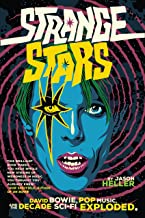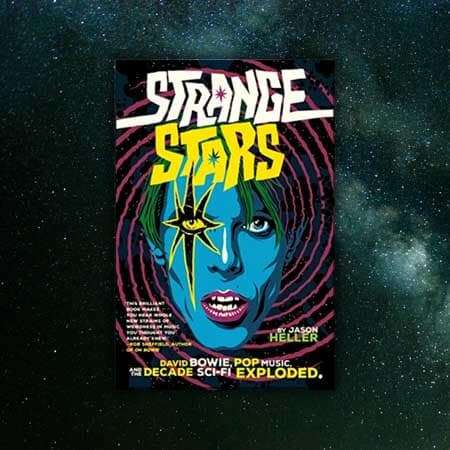Strange Stars: David Bowie, Pop Music and the Decade Sci-Fi Exploded by Jason Heller
At the time, Bowie was just a skinny singer with a dream, and a penchant for science fiction. After identifying with Robert Heinlein’s novel Starman Jones, about an Ozark farm boy who wants to go to space, Bowie devoured Ray Bradbury, Theodore Sturgeon, Isaac Asimov and all that the Golden Age of sci-fi could provide. Some of his earliest songs were abbreviated science fiction plots of strange worlds, strange creatures, stranger things. And in 1969, five days before NASA launched the Apollo 11 mission that landed the first two men on the moon, he pulled it all together and released “Space Oddity,” his sad song of Major Tom, sitting in a tin can. Soon afterward, he introduced himself onstage as Ziggy Stardust.
If you’ve never really thought about how science fiction inspired hundreds of songs you’ve been hearing all your life, Jason Heller pulls it all together for you in Strange Stars: David Bowie, Pop Music and the Decade Sci-Fi Exploded (Melville House Publishing).
 Heller is an intrepid explorer of both worlds. He’s a Hugo Award-winning writer and music journalist who plays in the post-punk band, Weathered Statues, and who DJs in Denver, where he lives. In example after example, Heller proves how science fiction and the real space race inspired pop music. Bernie Taupin’s songs for Elton John (“Take Me To the Pilot,” “The Cage,” “Bad Side of the Moon,” and, of course, “Rocket Man”) and Gil Scott-Heron’s ironic “Whitey On the Moon,” were only a few of the tunes that led to the realization that music itself could be science fiction. Case in point: In 1970, Paul Kantner and Jefferson Starship’s Blows Against the Empire album was nominated for a Hugo Award for Best Dramatic Presentation.
Heller is an intrepid explorer of both worlds. He’s a Hugo Award-winning writer and music journalist who plays in the post-punk band, Weathered Statues, and who DJs in Denver, where he lives. In example after example, Heller proves how science fiction and the real space race inspired pop music. Bernie Taupin’s songs for Elton John (“Take Me To the Pilot,” “The Cage,” “Bad Side of the Moon,” and, of course, “Rocket Man”) and Gil Scott-Heron’s ironic “Whitey On the Moon,” were only a few of the tunes that led to the realization that music itself could be science fiction. Case in point: In 1970, Paul Kantner and Jefferson Starship’s Blows Against the Empire album was nominated for a Hugo Award for Best Dramatic Presentation.
It’s all in this book, including a seven-page discography listing songs from dozens of artists: Jimi Hendrix, Marvin Gaye, David Crosby, Blue Oyster Cult, Pink Floyd, Yes, King Crimson, and others you’ve never associated with worlds beyond ours, until you think about it. Annotated and indexed, it’s a sci-fi fan’s joy, and a music lover’s bible.
Heller charts links from musician to musician, from concept to creation, from fantastic fiction to cascading sounds, from rock, to progressive rock, to psychedelic rock, to punk rock, to metal, to hard rock, to techno goth. Who knew that Marc Bolan was inspired to name his glam rock band T. Rex because of his childhood obsession with Ray Bradbury’s 1952 short story, A Sound of Thunder, in which hunters from the future use a time machine to return to the past to hunt dinosaurs, with disastrous results (see also T. Rex’s “Ballrooms of Mars” off the album The Slider).
Strange Stars is an account of parallel cultural forces that met in the recording studio. It ends on Bowie again, with the lead song to his 1980 album Ashes to Ashes, “funk to funky, we know Major Tom’s a junkie, strung out in heaven’s high, hitting an all-time low.” And what a long, strange trip it’s been.
Strange Stars: David Bowie, Pop Music and the Decade Sci-Fi Exploded is now available for purchase.
Buy this Book!
Amazon



